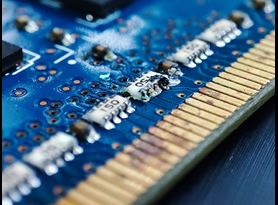Find the right strategy to prevent tin whisker growth in your electronic components with testing support from Element.
When used as a finish material for electronic components, pure tin can spontaneously grow conductive whiskers, forming unintended electrical paths and potentially causing serious problems for electronics of all types. The scientific community does not yet fully understand the reason for tin whisker growth, but proper laboratory testing of solder materials and electronic components helps substantially to mitigate tin whisker growth.
Until recently, most electronics have used lead solder, which melts at a low temperature and does not have the same propensity to grow whiskers, but the RoHS directive has banned the use of lead in solder, requiring most manufacturers to switch to a lead-free alternative. Unfortunately, this has increased the risk of tin whisker growth.
Tin whisker mitigation strategies
There is no single strategy to mitigate tin whiskers. Any mitigation strategy will depend upon the particular device. Some of the mitigation concepts are:
- Using conformal coating
- Avoiding tin-plated parts
- Selecting matte or low-stress tin finish
No matter what strategy or combination of strategies you employ, testing is crucial to determine if your mitigation strategy has proven effective.
How is tin whisker testing performed?
Tin whisker testing determines the product’s susceptibility to growing whiskers and can determine if your mitigation strategy is successful. Samples are subjected to three main environmental exposures, and during the exposure time, laboratory personnel periodically inspect the samples for any tin whisker growth. The three exposures are:
- Temperature cycling
- Ambient temperature-humidity storage
- High temperature-humidity storage
Element performs tin whisker testing per JEDEC, iNEMI, TSC0507G, TSC7038G and any customer-specific requirements. Our experts perform screening inspections with an optical stereomicroscope at the beginning of testing as well as at each designated time/cycle interval. If no evidence of tin whiskers is observed during this screening, we typically will not recommend further testing, which provides a cost savings to our customers, however, if evidence of tin whiskers is present, we use a scanning electron microscope (SEM) for a detailed inspection. This allows surface structures, anomalies, and contamination to be detected and isolated for further analysis.
The Element advantage
Element’s family of testing labs provides comprehensive testing and failure analysis services for electronic components of all types. Our experts are up to date on the latest test methods and standards and will work diligently to meet your requirements. To speak with an expert about our tin whisker testing services or any other electronic component testing, contact us today.
Learn more

Printed Circuit Board Testing
Ensure your printed circuit boards and finished printed circuit assemblies are of the highest quality and compliant with relevant standards with comprehensive PCB testing from Element.

Printed Circuit Board (PCB) Failure Analysis
Understand and rectify the root causes of PCB failure with industry-leading PCB failure analysis from the testing experts at Element.

Conformal Coating Inspection & Testing
Element provides industry-leading conformal coatings testing and inspection to a variety of standards, including MIL-I-46058C.

Solderability Testing
Trust Element’s testing experts for easy, accurate solderability testing of your electronic components.

